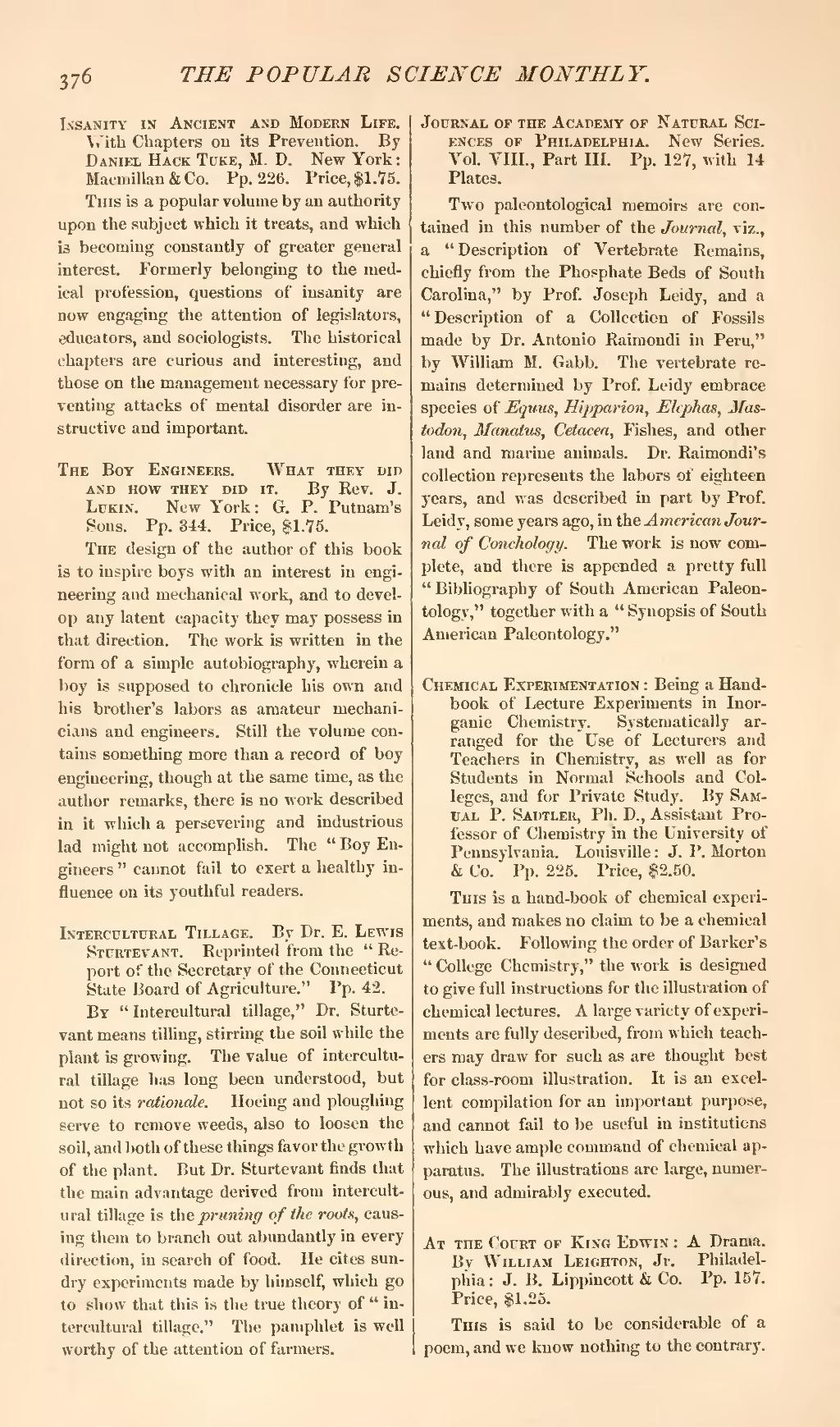Insanity in Ancient and Modern Life. With Chapters on its Prevention. By Daniel Hack Tuke, M. D. New York: Macmillan & Co. Pp. 226. Price, $1.75.
This is a popular volume by an authority upon the subject which it treats, and which is becoming constantly of greater general interest. Formerly belonging to the medical profession, questions of insanity are now engaging the attention of legislators, educators, and sociologists. The historical chapters are curious and interesting, and those on the management necessary for preventing attacks of mental disorder are instructive and important.
The Boy Engineers. What they did and how they did it. By Rev. J. Lukin. New York: G. P. Putnam's Sons. Pp. 344. Price, $1.75.
The design of the author of this book is to inspire boys with an interest in engineering and mechanical work, and to develop any latent capacity they may possess in that direction. The work is written in the form of a simple autobiography, wherein a boy is supposed to chronicle his own and his brother's labors as amateur mechanicians and engineers. Still the volume contains something more than a record of boy engineering, though at the same time, as the author remarks, there is no work described in it which a persevering and industrious lad might not accomplish. The "Boy Engineers" cannot fail to exert a healthy influence on its youthful readers.
Intercultural Tillage. By Dr. E. Lewis Sturtevant. Reprinted from the "Report of the Secretary of the Connecticut State Board of Agriculture." Pp. 42.
By "Intercultural tillage," Dr. Sturtevant means tilling, stirring the soil while the plant is growing. The value of intercultural tillage has long been understood, but not so its rationale. Hoeing and ploughing serve to remove weeds, also to loosen the soil, and both of these things favor the growth of the plant. But Dr. Sturtevant finds that the main advantage derived from intercultural tillage is the pruning of the roots, causing them to branch out abundantly in every direction, in search of food. He cites sundry experiments made by himself, which go to show that this is the true theory of "intercultural tillage." The pamphlet is well worthy of the attention of farmers.
Journal of the Academy of Natural Sciences of Philadelphia. New Series. Vol. VIII., Part III. Pp. 127, with 14 Plates.
Two paleontological memoirs are contained in this number of the Journal, viz., a "Description of Vertebrate Remains, chiefly from the Phosphate Beds of South Carolina," by Prof. Joseph Leidy, and a "Description of a Collection of Fossils made by Dr. Antonio Raimondi in Peru," by William M. Gabb. The vertebrate remains determined by Prof. Leidy embrace species of Equus, Hipparion, Elephas, Mastodon, Manatus, Cetacea, Fishes, and other land and marine animals. Dr. Raimondi's collection represents the labors of eighteen years, and was described in part by Prof. Leidy, some years ago, in the American Journal of Conchology. The work is now complete, and there is appended a pretty full "Bibliography of South American Paleontology," together with a "Synopsis of South American Paleontology."
Chemical Experimentation: Being a Handbook of Lecture Experiments in Inorganic Chemistry. Systematically arranged for the Use of Lecturers and Teachers in Chemistry, as well as for Students in Normal Schools and Colleges, and for Private Study. By Samual P. Sadtler, Ph. D., Assistant Professor of Chemistry in the University of Pennsylvania. Louisville: J. P. Morton & Co. Pp. 225. Price, $2.50.
This is a hand-book of chemical experiments, and makes no claim to be a chemical text-book. Following the order of Barker's "College Chemistry," the work is designed to give full instructions for the illustration of chemical lectures. A large variety of experiments are fully described, from which teachers may draw for such as are thought best for class-room illustration. It is an excellent compilation for an important purpose, and cannot fail to be useful in institutions which have ample command of chemical apparatus. The illustrations are large, numerous, and admirably executed.
At the Court of King Edwin: A Drama. By William Leighton, Jr. Philadelphia: J. B. Lippincott & Co. Pp. 157. Price, $1.25.
This is said to be considerable of a poem, and we know nothing to the contrary.

